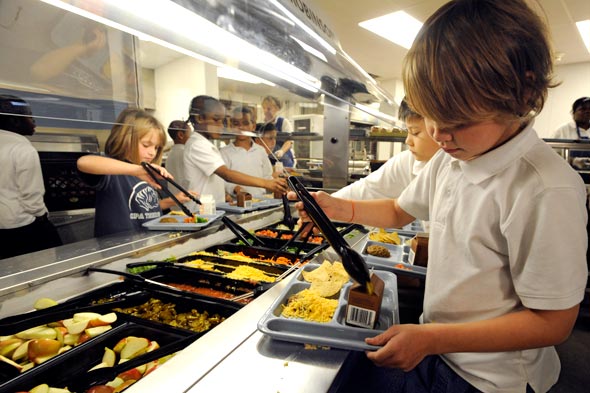
HATTIESBURG – (AP) As Mississippi school districts prepare to implement new federal school lunch rules next year, most also will increase lunch prices.
The Forrest County School District will probably up the price of a lunch from $2.25 to $2.50.
That doesn’t sit well with parent Sheila Thomas, who has three sons who pay for lunch at North Forrest High School.
“I would be OK with it if the quality of the food would be better, but I don’t anticipate it will be,” she said.
Thomas would like the district to offer more fresh options to her children, something director of child nutrition Kay Lawler said is happening to comply with the new federal meal rules.
“We’re already serving fresh fruits and vegetables every day,” she said. “(Students) are getting a fresh fruit or vegetable or both every day. We also serve dark green or orange vegetables three or more times a week.”
Thomas isn’t satisfied.
“I think a salad bar wouldn’t be that hard to do,” she said. “At the high school I went to – and this was 20 years ago – we had a salad bar. I think just having options.”
The new federal rules call for doubling fruits and vegetables at lunch and require a reduction in sodium and fat.
In addition, they specify that all grains served must be whole grains and all milk must be low fat.
The new rules are the first changes in 15 years to the school lunch program.
The other new law, also from the U.S. Department of Agriculture, has to do with school lunch prices.
Federal reimbursements for full price school lunches don’t cover the cost of food in many school districts.
The USDA Child Nutrition Authorization Act now requires public schools to charge an amount that is equal to the difference between the reimbursement the agency pays for students who receive free meals and what the agency reimburses for students who pay the full price for meals.
Schools have several years to make up that difference.
On average school districts in the U.S. are reimbursed 26 cents for every paid meal served and $2.77 for every free meal served.
In the Petal School District, it costs $3 to produce a school lunch, said director of child nutrition Danny Dillistone. The district charges $2.25 for a paid meal.
Federal officials want to make sure the reimbursement money for free meals is not subsidizing students who pay the full price for lunch, Dillistone said.
“USDA doesn’t want free children carrying the whole program,” he said.
Hattiesburg Public School District’s director of child nutrition Stephanie Hoze has already told her school board prices are increasing.
“We can no long allow our program to operate and be funded by our free and reduced student,” she said. “I don’t know what the increase will be next year, probably 10 cents or 25 cents.”
The district currently charges $2 for a full-price lunch.
Hoze said the district is already offering more fresh choices on its menus. A survey by the nutrition office shows district staff believe the district’s fresh fruit and vegetable program is on track.
Fifty-seven percent of staff highly approved of the variety of produce served, while 48 percent gave a high approval rating to the quality of produce served.
Forrest County Agricultural High School’s director of child nutrition Tom Chambliss said lunch prices will be going up at the school, but he’s not sure yet what the increase will be.
“They will go up. We’re trying to keep ours at a minimum,” he said.
The current price of a lunch is $2.25.
The price of a lunch has already gone up in Lamar County School District. The district raised prices by 25 cents this year to $2.50.
The district began offering more fresh choices to make up for the increase, said co-director of child nutrition Julie Hamilton.
The district used to offer a canned fruit and a fresh fruit at lunch. Now it offers four fresh fruit choices and a hot and a fresh vegetable choice.
It requires students to pick up at least one serving of a fruit or a vegetable. And students don’t have to stop at one.
“Now you can have all four (fruits),” said Hamilton.
Hamilton said the price increase went into effect with no complaints from parents and no reduction in the number of paying customers.
Dillistone hopes the same will happen in the Petal School District.
“Usually when you go up in price, you lose some participation,” he said. Lawler is also worried about losing some of her customers.
“That’s always a concern,” she said. “That’s why we try not to raise prices any more than we have to.”
Chambliss, too, said participation will likely decrease.
And Hoze expects to see her numbers go down.
“Anytime we increase our meal costs, participation does decrease,” she said. “It is really a major concern for me to have to increase meal costs next year.
“It does become a challenge when (a family has) a number of children in school. Families may find it more economical to prepare a lunch at home.”




Be the first to comment